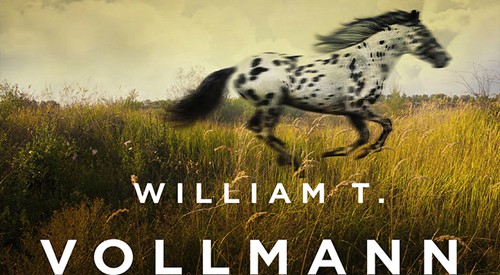Books & Culture
Friend and Enemy Alike: The Dying Grass by William T. Vollmann

William T. Vollmann’s new novel, The Dying Grass, might be the longest volume ever published about the 1877 Nez Perce Indian War — it is certainly the longest work of fiction. However, for a novel, Vollmann’s book is uncommonly authoritative and well researched. In The Dying Grass, Vollmann uses the vehicle of fiction to immerse his readers in the history more effectively than any amount of straightforward journalistic reportage ever could. Vollmann does not depart from historical record so much as he alchemizes it into a fever dream. These are the late years of the Indian wars, and by bringing them to life, Vollmann vividly recreates some of the darkest moments of American history.
The Dying Grass is the fifth book in Vollmann’s Seven Dreams series — a seven volume cycle of novels examining the conflicts between the Native Americans and the European colonizers. The series began with The Ice Shirt (1990), which dealt with the Norse discovery of America. Each consecutive book in the series has moved readers slightly closer to the present day. The Dying Grass positions itself at a critical junction of American history: between pioneer times and the industrial era. Following the classic Western-genre tradition, The Dying Grass is a kind of elegy to the Old West and to traditional Native American culture.
The Dying Grass is an accurate and finely detailed account of the five month Nez Perce War: the war in which the Nez Perce war chiefs: Joseph, Looking-Glass and Toohoolhoolzote, through a series of brilliant military decisions, outmaneuvered, confounded and held at bay General Oliver O. Howard and his much larger U.S. military force. These Nez Perce leaders, Chief Joseph the most famous of the three, led less than a thousand Indians — mostly women and children — on a 1,200-mile fighting retreat across what is now Montana, Idaho and parts of Wyoming. This chase gives Vollmann’s book structure and urgency. It is not a meandering collection of researched details with a fictional plot imposed; rather, it is a tightly structured novel of pursuit, full of reluctant heroes, each, by turns, the hunter and the hunted.
It is difficult to describe The Dying Grass without describing the way Vollmann arranges words on the page. While the plot is simple, the structure is unique and complex. Each chapter contains a chorus of divergent voices, which the reader must navigate in order to make sense of the narrative. Characters and locations shift without warning, often in the middle of a conversation. Rarely will dialogue be tagged; breaks are only indicated by a section’s indentation. Some half-finished conversations resolve later in the chapter, while others do not. Some pages contain so many differently indented sections that the text sits on the page more like the stanzas of some modernist poem than a novel. Certain pages resemble games of Tetris gone horribly wrong.
This might seem edgy or experimental to some readers, but there is nothing flashy about the way Vollmann constructs his narrative. In this case, the tool seems to have been inspired by the task. Vollmann needs this structure to demonstrate the breaks between voices, and he needs the breaks between voices to submerge the reader in each scene. This small innovation saves him the trouble of constantly needing to introduce characters, tag dialog and set scenes. The final effect is completely immersive. Vollmann gives the reader enough information to continue on the journey, but not so much as to distract attention from the scene.
Because of the way Vollmann structures his chapters, readers have access to nearly two hundred characters’ thoughts, feelings, private conversations, dreams and memories, unified only by date and place. The Dying Grass is the story of a hard journey shared by all of Vollmann’s characters: friend and enemy alike. Nearly all of the information, events and actions of the book are filtered through a character’s point of view, and though it is not always clear whose, one feels surrounded by the story’s action. We follow both real and fictional characters on both sides of the conflict; we inhabit warriors as they kill and as they are killed; we freeze and starve with the elderly, the children and other non-combatants; we jockey with the West Point brass safely encamped behind the skirmish lines; we endure weeks of mind numbing travel; we shoot our worn out horses so that our enemies cannot make further use of them.
If this style were transposed into to a shorter work, it likely would not function. These half developed conversations, unfinished thoughts and daily minutia would frustrate most readers if taken in a small dose — and even in this long narrative, it took me nearly a hundred pages to acclimate to the book’s style. Any one of these points of view alone could furnish a short novel, but because of The Dying Grass’s bigness, the final effect is fresh, lifelike and complete — it is, indeed, a fully inhabitable dream — more a lived experience than a long book.
And yes, it is a long book. And like all long books, it is tedious in places. Around the 600-page mark, The Dying Grass feels oceanic and nearly unnavigable. Unlike many long novels, there are very few tangential sections not directly related to the plot — no 100 page essays about whaling, for example, or digressive histories about the battle of Waterloo or Alcoholics Anonymous to give the reader a respite from the repetition of the novel’s relentless structure. The book is fully character-based. It is a single, long and exhausting chase, which takes a huge toll on each character, and as a reader, one feels the characters’ exhaustion palpably.
The time necessary to tackle a book of this length, in itself, builds a kind of empathetic bridge between text and reader. Anyone familiar with long novels will recognize this version of Stockholm Syndrome — because you have been imprisoned by the book for so long, you become loyal to it. You begin to forget that other books even exist. At 1,356 pages, roughly each mile of the Nez Perce fighting retreat receives a full page of coverage. There are moments where the very experience of reading The Dying Grass parallels that forced march through the untamed West: the cold, the hunger and the thirst endured by both the Nez Perce and the American soldiers, paralleled by intellectual forced march a reader must take to reach the books final 200 pages of endnotes.
Reading The Dying Grass is a powerful and visceral experience. Most of us know about the destruction of the Native American tribes, and intellectually, most people will agree that it was a tragic blunder of American policy, but it has been a long time since I was able to emotionally connect to the disaster of it. The genocide of the Native American Indians is such a difficult concept to swallow, that it is rare to be reminded in a way that feels genuinely moving and not somehow trite or preachy. Vollmann achieves this by sticking to the facts and by moving slowly. The book is powerfully neutral, grounded in ambivalence toward both the Nez Perce and the American soldiers. Both sides perpetuate good and evil here, both sides are deeply sympathetic, and while this is certainly a political story, because Vollmann writes without a clear position or agenda, it works.
In The Dying Grass, Vollmann gives us a difficult book well worth the effort. He manages to seamlessly wed a historian’s eye for researched detail with a fiction writer’s ability to inhabit character and place. By welding these disciplines together, Vollmann manages to bring his readers the best of both worlds. This is a significant novel that returns to us an often forgotten story from the late years of the Indian Wars. It resurrects a part of our American cultural memory that many of us have forgotten. It probably won’t make a great beach read, but it might be the most important book you read this year.









